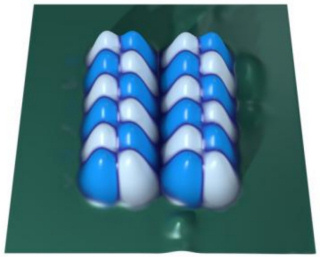Allgemeines Physikalisches Kolloquium im Sommersemester 2012
Ort: 48149 Münster, Wilhelm-Klemm-Str. 10, IG I, HS 2,
Zeit: Donnerstag, 05.04.2012 16:00 Uhr c.t.
Kolloquiums-Kaffee ab 15:45 Uhr vor dem Hörsaal
Atomic-scale engineering of nanomagnets
Dr. Sebastian Loth, Max-Planck Department for Structural Dynamics, Center for Free-Electron Laser Science CFEL
Magnetism is an intriguing property of matter that gives rise to a host of physical phenomena and technological applications. In this talk I will focus on quantum mechanical effects that appear when a magnet is shrunk to the size of just a few atoms. In this limit the magnetization of a magnetic particle transforms into a set of discrete spin states and magnetic tunneling can be observed.
Scanning Tunneling microscopes operating at low temperature haven proven to be excellent tools to address magneticparticles, molecules and atoms. We use inelastic electron tunneling spectroscopy for studies of static and dynamic properties of magnetic atoms on surfaces. In contrast to conventional elastic conductance spectroscopy, this technique maps the excitations between energy eigenstates of the atomic spins and obtains microvolt energy resolution [1]. Time resolution in the nanosecond range can be obtained by pulsed excitation schemes [2]. We use this capability to quantify the spin relaxation time of individual magnetic atoms.
We map the variations of the spin relaxation time for spins in different local environments and find that minute interactions with spins at a distance of up to 3 nm have a measurable influence on the electron spin relaxation time. Here we use the STM’s ability to move individual atoms and construct different arrangements of magnetic atoms that either stabilize or destabilize the spins.
In particular I will show that antiferromagnetic interaction can lead to the emergence of extremely stable magnetic states [3]. We assembled arrays of iron atoms on a copper nitride, Cu2N/Cu(100), surface. With increasing number of atoms these spin arrays transition from a quantum mechanical singlet ground state to a degenerate doublet of classical antiferromagnetic states. This transition is accompanied by a drastic change in the observable spin dynamics. The iron spin arrays represent a new class of artificial antiferromagnets and can be used for model demonstration of dense magnetic data storage where one bit of information can be stored in as few as 12 atoms.
| [1] C. F. Hirjibehedin et al, Science 317 1199 (2007). [2] S. Loth et al, Science 329 1628 (2010). [3] S. Loth et al, Science 335 196 (2012). |
 |
Scanning Tunneling Microscope image of an array of 24Fe atoms on Cu2 N/Cu(100). The Fe atoms were arranged such that they form two independent antiferromagnetic particles. Color denotes magnetic the magnetic order. |
Einladender: Prof. Dr. D. Wegner
Im Auftrag der Hochschullehrer des Fachbereichs Physik
Prof. Dr. Sergej Demokritov
